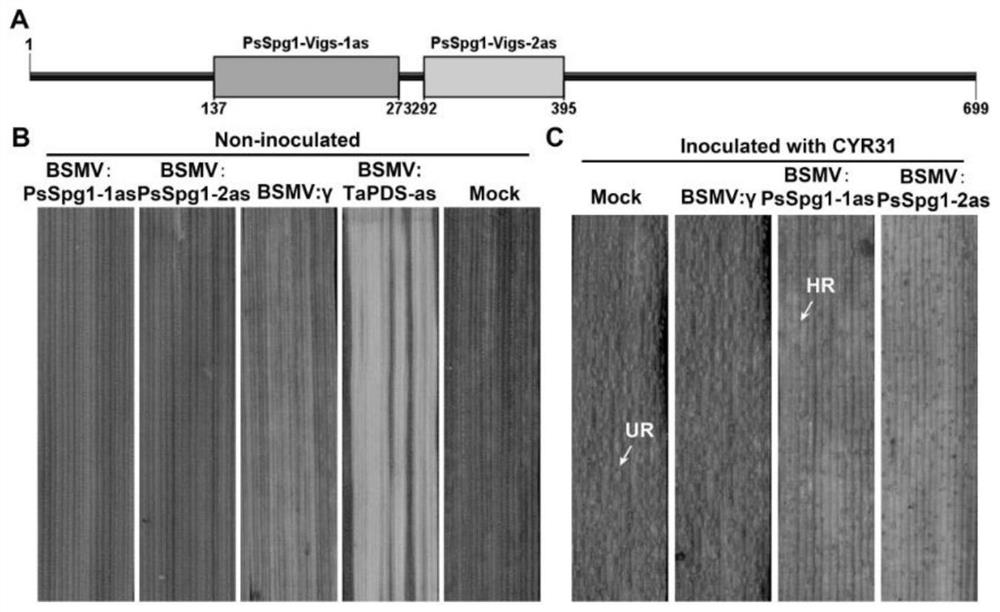Wheat stripe rust secretory protein, identification method, transgenic plant and application
A technique for secreting proteins from wheat stripe rust, which is applied in the fields of application, chemical instruments and methods, botany equipment and methods, etc., and can solve problems such as environmental pollution and drug resistance of pathogens
- Summary
- Abstract
- Description
- Claims
- Application Information
AI Technical Summary
Problems solved by technology
Method used
Image
Examples
Embodiment 1
[0039] The invention proves the important role of the stripe rust fungus secreted protein gene Spg1 in the stripe rust fungus infecting wheat.
[0040] After identification, it was found that the Spg1 transgenic silenced plants showed resistance to the popular races in the field. Therefore, the secreted protein gene can be used to create broad-spectrum rust-resistant wheat materials, thus providing excellent wheat resources for the breeding of stripe rust-resistant varieties .
[0041] When inoculated with stripe rust for 14 days, the biomass of stripe rust in the silenced plants of Spg1 was reduced by 24.1-46.4% compared with the control, which played a better effect of preventing and controlling stripe rust infection.
[0042]本发明实施例提供的条锈菌分泌蛋白的核苷酸序列如SEQ ID NO.1:atgtcacattccaactctgcaatgcctaccggctcatcatcatcatcctcaacaaccaccacggggggagcaccaactagtagtaatccaccaccatccagcaatcaaagtgaagataagaactcagtcgtcatcaaggtcggaatggtcggagattcgcagatcggtaaaacaagtttaatggtcaaatatgtcgaaggaagttttgatgaagatta...
Embodiment 2
[0045] The invention provides a method for identifying the effect of wheat stripe rust comprising the following steps:
[0046] In the first step, based on the qRT-PCR method, it was determined whether the effect gene Spg1 of stripe rust was involved in the process of stripe rust infecting the host.
[0047] The specific method is: using the stripe rust elongation factor gene PsEF1 as an internal reference, and using the specific fragment primer of the stripe rust effect gene Spg1 to perform qRT-PCR to determine the effect of stripe rust effect gene Spg1 on different infection stages of stripe rust infection in wheat (the initial stage of infection, the live parasitic stage, the late stage of infection and the expression level of sporulation stage);
[0048] SEQ ID NO: 3:
[0049] Internal reference primers:
[0050] Forward primer: PsEF1-F: ttcgccgtccgtgatatgagacaa; reverse primer: PsEF1-R: atgcgtatcatggtggtggagtga.
[0051] SEQ ID NO: 4:
[0052] Gene quantification prim...
Embodiment 3
[0058] The invention provides a transgenic plant silenced by an effector gene. First, the RNAi vector of Spg1 is constructed, and the genetic transformation mediated by Agrobacterium is used to obtain the transgenic plant of Spg1-RNAi, and the resistance of the transgenic plant to stripe rust is verified. Is it significantly improved.
[0059] SEQ ID NO: 5:
[0060] Vector construction primers for silent fragments:
[0061] Forward primer: Spg1-RNAi-F:
[0062] ggggacaagtttgtacaaaaaagcaggcttcagcgtagtctgggacgtcgtatgggtaaggtcggaatggtcg
[0063] Reverse primer: Spg1-RNAi-F:
[0064] ggggaccactttgtacaagaaagctgggtcctaagcgtagtctgggacgtcgtatgggtacgtatttcggatgga
[0065] The technical effect of the present invention is described in detail in No. 2 experiment of the following street.
[0066] The control effect of stripe rust in this experiment: After using the transient system to silence the stripe rust effect gene Spg1, the biomass of stripe rust inoculated for 14 days decreased...
PUM
 Login to View More
Login to View More Abstract
Description
Claims
Application Information
 Login to View More
Login to View More - R&D
- Intellectual Property
- Life Sciences
- Materials
- Tech Scout
- Unparalleled Data Quality
- Higher Quality Content
- 60% Fewer Hallucinations
Browse by: Latest US Patents, China's latest patents, Technical Efficacy Thesaurus, Application Domain, Technology Topic, Popular Technical Reports.
© 2025 PatSnap. All rights reserved.Legal|Privacy policy|Modern Slavery Act Transparency Statement|Sitemap|About US| Contact US: help@patsnap.com



